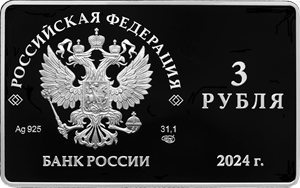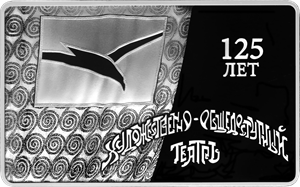The 125th Anniversary of the Moscow Art Public Theatre Founded by K.S. Stanislavsky and V.I. Nemirovich-Danchenko
Obverse
the left part of the rectangular coin features an image of the National Coat of Arms of the Russian Federation, with the inscription above it in a semicircle ‘РОССИЙСКАЯ ФЕДЕРАЦИЯ’ (RUSSIAN FEDERATION) framed with paired diamonds on both sides, under the national coat of arms are the chemical symbol and fineness of the metal on the left and fine metal content and the trademark of the mint on the right, and the inscription ‘БАНК РОССИИ’ (BANK OF RUSSIA) below; the right part of the coin bears the coin denomination in two lines ‘3 РУБЛЯ’ (3 RUBLES) and the year of issue ‘2024 г.’ (2024).
Reverse
an image of the historic front curtain with a flying gull, laser treated for matte finishing and the relief inscriptions on the right: ‘125 ЛЕТ’ (125 YEARS) in two lines at the top and ‘ХУДОЖЕСТВЕННО-ОБЩЕДОСТУПНЫЙ ТЕАТРЪ’ (ART PUBLIC THEATRE) in a stylised font in two lines at the bottom.
Authors
Designers: E.V. Kramskaya (obverse), A.D. Schablykin (reverse).
Sculptors: A.A. Dolgopolova (obverse), computer simulation (reverse).
Mint: Saint Petersburg Mint (СПМД).
Edge: 200 corrugations.
Discover more
On 14 (26) October 1898, in Moscow, the performance of Tsar Fyodor Ioannovich was the inaugural production of the Moscow Art Theatre (MAT), a new open theatre created by Konstantin Stanislavski and Vladimir Nemirovich-Danchenko.
The core of the troupe was made up of the most gifted members of the Drama Circle of the Society of Art and Literature (M. Lilina, M. Andreeva, V. Lyzhski, and A. Artyom) and Nemirovich-Danchenko’s students from the School of Music and Drama of the Moscow Philharmonic Society (O. Knipper, I. Moskvin, V. Meyerhold, M. Savitskaya, M. Roksanova, and N. Litovtseva). Later, A. Vishnevski, V. Kachalov, and L. Leonidov joined the troupe.
In his speech addressed to the troupe before the opening of the Moscow Art Theatre, Stanislavski said, ‘Do not forget that we are striving to illuminate the gloomy life of the poor, give them happy and beautiful moments in the darkness around them. We are trying to create the first reasonable and moral public theatre, and dedicate our lives to this ambitious goal.’
As conceived by the founders of the MAT, its main task was to search for the ways to stage new dramaturgy that outgrew the old theatre. It was planned to work with dramas written by Chekhov, Ibsen, and Hauptmann.
Yet, the true birth of the new theatre, according to its founders, was the production of the Seagull by A. Chekhov. It was the production of Chekhov’s plays that helped create a new acting system, which defined the theatre of the 20th century, and formulated new principles of directing, creating a ‘mood’, and the general atmosphere of a theatrical performance. For the first time in the history of the world theatre, the MAT affirmed the important role of the director as the author of a performance who interprets a play according to the specifics of his creative vision. The MAT was the first to formulate and test the techniques of the Stanislavski system, which were to become the basis for the training and education of actors throughout the world.
For its first four seasons (1898–1902), the MAT rented small premises in the Hermitage Garden. In 1902, through the efforts of S. Morozov, a Moscow’s famous entrepreneur and philanthropist, the theatre moved to a new location (a building reconstructed by F. Shekhtel) in Kamergersky Lane. The grand opening ceremony of the new building took place on 26 October (8 November) 1902 with the performance of The Philistines by M. Gorky.
In 1919, the MAT became an academic theatre. In 1932, it was named after M. Gorky.
In 1923, the theatre opened a museum with two branches: the House Museum of K. Stanislavski and the Memorial Flat of V. Nemirovich-Danchenko. In 1943, the Studio School named after V. Nemirovich-Danchenko was established and has been operating since then.
In 1984, the theatre split into two independent companies: one was headed by O. Efremov (since 1989, the Moscow Chekhov Academic Art Theatre, located in Kamergersky Lane) and the other – by T. Doronina (the Moscow Gorky Academic Art Theatre, located in Tverskoy Boulevard).
In 2004, the theatre in Kamergersky Lane, directed by O. Tabakov, excluded the word ‘Academic’ from its name and returned to the original wording: the Moscow Chekhov Art Theatre.
Source: https://www.prlib.ru


